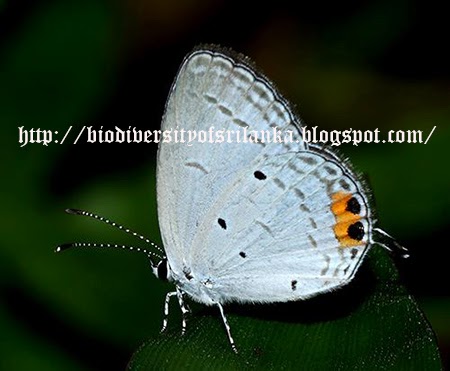Common insect found in lowland paddy fields
and grasslands up to about 500 m a.s.l. Its larva feeds on paddy (Oryza sativa), Leersia hexandra (ලෙව්/Bareet Grass) and also on Carpet grass/පොටු තණකොළ (Axonopus compressus) when offered.
Pages
- Home
- Flora of Sri Lanka
- Dragonflies & Damselflies of Sri Lanka
- Butterflies of Sri Lanka
- Freshwater Fishes of of Sri Lanka
- Amphibians of Sri Lanka
- Snakes of Sri Lanka
- Tetrapod Reptiles of Sri Lanka
- Mammals of Sri Lanka
- Resident Birds of Sri Lanka
- Migrant Birds of Sri Lanka
- Vagrant Birds of Sri Lanka
- Status Uncertain or Doubtful Birds of Sri Lanka
Saturday, October 13, 2012
Thursday, October 11, 2012
Tuesday, October 9, 2012
Common Redshank (Tringa totanus)
Common Redshank is a common winter migrant
mainly to the dry coastal areas. It is less common in wet zone and occasionally
occurred in inland. It feeds on crabs, mollusks, worms and other aquatic
animals in shallow water in mudflats, salt marshes, coasts, lagoons, etc
solitary or as small groups, sometime with other waders. Race eurhinus (Status of the other race terrignotae in Sri Lanka is considered as uncertain) which is the most common in Sri Lanka Central Asia .
සිංහලෙන් කියවන්න >>
Sunday, October 7, 2012
Friday, October 5, 2012
Indian Cupid (Everes lacturnus parrhasius)
Rather uncommon butterfly occurs all over
the island in all the year round from sea level to about 1500m a.s.l. Larva
feeds on Grona heterophylla (මහ උඳුපියලි/Spanish clover), Grona heterocarpos (ඇත් උඳුපියලිය/Asian ticktrefil), Desmodium triflorum (හීන් උඳුපියලිය/Creeping tick threefoil/Tick clover), Desmodium uncinatum (Silverleaf Desmodium) and Desmodium pryonii of the family Fabaceae.
Wednesday, October 3, 2012
Brown Shrike (lanius cristatus)
Brown shrike is a migrant to the island. It
occurs as two races in Sri Lanka Sri Lanka
සිංහලෙන් කියවන්න >>
Monday, October 1, 2012
වද/සපත්තු මල්[Wada/Sapaththu Mal]/Shoe-Flower/Chinese Hibiscus (Hibiscus rosa-sinensis)
Large shrub with flowers with varies colors
such as red, white, orange, pink, purple, yellow and sometimes brownish-yellow
with a red center etc. It is native plant of China
Saturday, September 29, 2012
Chestnut Bob (Iambrix salsala luteipalpus)
Common insect found in jungles and
scrublands in all elevations of the island throughout the year (Gamage R., 2007).
More common in wet zone and probably scarce
or absent in higher hills and northern part of the country according to the
Ormiston (Ormiston W., 1924). The larva feeds on Axonopus compressus, Ochlandra stridula, Oryza sativa, Ischaemum timorense and Eragrostis viscosa
Thursday, September 27, 2012
කුරුළුගොයා[Kurulugoya]/Shikra (Accipiter badius badius)
Common breeding resident throughout the
island. It avoids dense forests and can be found in open areas, plantations,
village gardens and even in towns with some trees. Shikra preys mainly on small
birds and lizards. It usually perches high in a tree watching for a prey and
flies down to catch it with talons. It breeds from March to May and probably
again in August to September and build a nest with twigs and grasses place
among foliage high in a big tree.
සිංහලෙන් කියවන්න >>
Tuesday, September 25, 2012
Sunday, September 23, 2012
Common hourglass tree frog (Polypedates cruciger)
An arboreal frog of about 60mm snout to vent length of male and 90 of
female. Endemic to Sri Lanka and distributed in both wet and dry zone up to
about 1525m a.s.l though not much common in dry zone. It is much common around
anthropogenic habitats and usually it is encountered inside bathrooms, overhead
water tanks, banana groves and other such vegetation.
Friday, September 21, 2012
Milky Cerulean (Jamides lacteata)
 Rare and endemic butterfly found in mid country. Ormiston recorded it from Haldummulla, Wellawaya, Monaragala, Ratnapura,
Rare and endemic butterfly found in mid country. Ormiston recorded it from Haldummulla, Wellawaya, Monaragala, Ratnapura, Wednesday, September 19, 2012
Monday, September 17, 2012
බට්ටිච්චා[Battichcha]/Common Tailorbird (Orthotomus sutorius)

Very common breeding resident found in wooded
areas and home gardens both in villages and towns in al climatic zones of the
island. It keeps in pairs and actively feeds on small insects, spiders etc. among
foliage of trees and bushes, usually uttering its loud and rather monotonous
call to keep in touch with its partner. It breeds probably throughout the year
but the main season appears to be February to March. Common Tailorbird builds its nest in a cavity
formed by sewing together either the sides of a large single leave or of two or
more smaller leaves, where it lays 2-3 eggs.
සිංහලෙන් කියවන්න >>
Saturday, September 15, 2012
Thursday, September 13, 2012
Common Treebrown (Lethe rohria)
Common butterfly found in hills (Between
500 and 5000ft) throughout the year. Scarce in lower elevations. It only
flies very short distance at a time. No records available on its larval host plant or on early stages in Sri Lanka.
Tuesday, September 11, 2012
Sunday, September 9, 2012
ගේ කුරුල්ලා[Ge-Kurulla]/House Sparrow (Passer domesticus)
Common breeding resident inhabiting close to the human
habitations throughout the country. It feeds in flocks on seeds, insects and
food wastes around human dwellings. House Sparrow breeds throughout the year and nest is a
mass of grass, straws, etc., line with feathers and place in a cavity in a
building. But usually people use to put up earthenware chatties on the walls of
houses for these birds so that they can utilize them for nests.
සිංහලෙන් කියවන්න >>
Friday, September 7, 2012
Wednesday, September 5, 2012
Indian Fritillary (Argynnis hyperbius taprobana)
An uncommon butterfly found in hills above 1500m throughout the year. It usually encounters in Patana lands close to forests. Its larval host plants are Viola betonicifolia (Violet) of family Violaceae, a very common weed of tea plantations. It also feeds on Viola pilosa of the same family. Indian Fritillary sometimes basks on pathways and streams, wings outstretched flat and usually coming to the same spot or flies short distance if disturbed.
Subscribe to:
Posts (Atom)


















